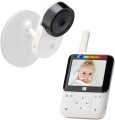—
Two-way talk. This function provides two-way communication: you can not only hear the baby, but you can also talk to him/her. For example, if the baby woke up late, the parent's voice may lull him/her back to sleep. In addition, two-way communication can come in handy when the baby grows up — a baby monitor with such an opportunity actually turns into a portable walkie-talkie that can be used in games or hiking.
—
Camera control. The ability to control the baby monitor camera (refer to "Product type") from the parent unit. This greatly expands the possibilities for monitoring the child's room: for example, if the child got up from the crib and is not in the camera's field of view, you can turn the lens and control what exactly the child is doing.
—
VOX mode. A system that reduces the power consumption of the parent unit, and consequently its runtime without recharging the batteries. It can be realized in different ways. For example, the parent unit can be constantly in a kind of “sleep mode” (LEDs are not lit, the display does not show anything, etc.), until the child unit detects any significant sound or the touch mat is triggered (see below); in some models, this mode can be switched on and off manually. Another option is the special ECO mode, which reduces transmitter power and therefore power consumption; it can be activated when the distance betwee
...n units is short and significant power is not required.
— Volume control. The ability to adjust the volume of the sound of the parent unit. For example, in a noisy kitchen, the volume can be set to maximum to ensure that you can hear the sound from the speaker, and in a quiet atmosphere, the volume can be lowered to keep relatively soft sounds out of the way.
— Activity light indication. Baby monitors with this function are equipped with a special indicator that gives a light signal if the microphone of the child unit picks up noise in the room. Many models have a gradation of signals: for example, if the child just turned in his/her sleep, one LED is activated, and if he/she started crying, the entire set lights up. Such an alarm usually plays a supporting role, complementing the main speaker of the parent unit; in addition, in such devices, the speaker can often be turned off altogether and the baby monitor can be used in silent mode, with only a light indication.
— Vibration mode. Indication of activity in the child's room (increase in noise level) by vibration of the parent unit, similar to a vibration signal in mobile phones. Similar to light, such an alarm serves as an addition to the main speaker and can be used both in parallel with it, and separately as a silent mode; at the same time, it is more convenient than the light one (see above) — the parent does not have to constantly look at the device, because even without seeing it, he/she will immediately know about the operation. On the other hand, the price of models with vibration is higher.
— Out of range indicator. A special alarm on the parent unit, warning of the loss of communication with the child's unit. Without communication, the baby monitor becomes useless, and even dangerous, because the silence of the parent unit creates a false confidence that all is well. The presence of an out of range indicator will help to avoid such situations. Such an indicator can be visual (light indicator, signal strength indicator) or sound.
— Card reader. A card reader allows the device to work with removable memory cards — usually SD or microSD; the specific format and subtype of compatible cards needs to be specified separately. However, this function provides various additional features anyway. Memory cards are intended for storing recorded videos and photos (refer to "Baby unit"), downloading melodies for a music box, software updates, etc.
— Headphone output. A connector (usually a standard mini-jack 3.5 mm) that connects headphones to the parent unit and can be used to hear all sounds through the headphones. This feature can be useful, for example, if it is necessary to maintain maximum silence and any excessive sounds in the location of the parent unit are not desirable at all, or in a noisy place where there is a risk of missing a signal.
— Low battery indicator. The indicator that shows when the batteries in the parent unit are low. Usually, it warns in advance of the need to change or charge batteries, which reduces the likelihood of an unexpected failure of the baby monitor at the most inopportune moment.
— Timer. A kind of analogue of an alarm clock: after a specified time, the parent unit gives a signal, and parent will not miss the right moment (for example, when it is time for the baby to get up).
— TV connection. This provides the ability to watch the baby unit's broadcast on a TV, because the own screen of the baby monitor, even in the largest models, is very small (refer to “Screen size” for details) and not even comparable to the most compact TVs. In addition, the connection to a TV makes it possible to record video even if the baby monitor itself does not have such function (see below for more information on recording).
